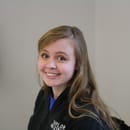Whether or not they have been noticed, women have been responsible for some of the most essential innovations in science, math, and policy. Women had to fight to get the education necessary to be doctors and researchers, while likely not being respected within their field. For example, women were allowed to attend Saint Louis University in 1908, but women of color were not given this right until well after 1944. While being held back in almost every facet possible, women managed to create their own paths in the sciences.
For example, Rosalind Franklin worked with x-ray crystallography to visualize the structure of DNA. She produced some of the most visually revealing pictures of the helical structure of DNA. These photos are said to be responsible for Watson and Crick’s realization of the double helical structure of DNA. They published their discovery in Nature in 1953 and merited the Nobel Prize from this discovery, yet Franklin’s role in this discovery was not realized until decades later. In this specific example, and for all of the women who have been passed over, I’d like to highlight some women in science you should know:
Gladys West is a pioneer in the development of the Global Positioning System (GPS). She was from a small county south of Richmond, Virginia and worked through high school and college to pursue a career in the sciences. West worked the majority of her life synthesizing data from satellites that contributed to the accuracy of our current GPS system. She worked quietly with these GPS data that perfected our current system. West’s work was focused on creating an accurate computer model of the earth. She worked for the Naval Surface Warfare Center: Dahlgren Division and was the second black woman employed there. She worked diligently and quietly, as it was largely unknown that her work was influential in creating a working GPS. In 2018, her efforts were eventually recognized. At the age of 87, she was inducted into the Air Force Space and Missile Pioneers Hall of Fame.
Dr. Hayat Sindi is one of the world’s leading biotechnologists who has spent her life in the pursuit of humanitarian work. Born in Makkah, Saudi Arabia, Sindi worked to be admitted into several prestigious universities, especially in a male-dominated field. She was the first woman from the Gulf to receive a degree from Cambridge. Her work since acquiring her PhD has been focused on low-cost medical monitoring technology. Her nonprofit works to create small health monitors that test body fluids and give almost immediate results. The first of these monitors was created to test liver health, as in rural places, it is extremely difficult to find consistent, fast medical care. Dr. Sindi has spoken at length about women in science and states, “Women really need to believe that they are amazing, talented, articulate, beautiful, and they really should believe that they can do anything. In science, they are better engineers than men, because they don’t give up, they seek solutions, and they always persist.” Dr. Sindi places emphasis on how essential it is to be a humanitarian while being a scientist.
CRISPR-Cas9 is a genome-editing technique for which early research began in 1987. Clustered Regularly Interspaced Short Palindromic Repeats (CRISPR), is an extremely precise and efficient method of editing a specific genome. It is extremely customizable, which greatly increases its utility. While several labs worked to develop this technique from its origin in archaea, Dr. Jennifer Doudna and Dr. Emmanuelle Charpentier, who worked at University of California, Berkeley, played an undeniable role in its popularity. They utilized an enzyme called Cas9 in their specific research. However, Doudna and Charpentier were not granted the patent for CRISPR. Doudna’s and Charpentier’s discoveries have been called one of the greatest molecular technologies of this century.


